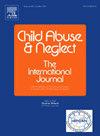家庭治疗法庭中的依恋和生物行为追赶参与与团聚。
IF 3.4
2区 心理学
Q1 FAMILY STUDIES
引用次数: 0
摘要
背景:受药物影响的儿童参与儿童福利的风险增加,这往往会导致家庭外护理。药物滥用障碍(SUD)会影响家庭单位,因此,预防和干预工作需要以家庭为目标,而不仅仅是以患有药物滥用障碍的个人为目标。针对受 SUD 影响的家庭有一些有效的干预措施,但有关服务后家庭团聚结果的信息却很有限:本研究探讨了在儿童福利案件尚未结案的条件下,参与依恋和生物行为追赶(ABC)模式是否与参与家庭治疗法庭(FTC)的家庭实现团聚的更高可能性相关:研究样本包括来自 112 个家庭、年龄在 6 个月至 47 个月之间的 215 名儿童及其照顾者,他们都因酗酒而被纳入家庭治疗法庭。如果儿童或其兄弟姐妹参加了亲生父母或寄养父母的干预,则被视为接受了干预(人数=39;18.1%)。ABC疗法由训练有素的治疗师在家中或通过远程医疗提供:结果:研究结束时,74%接受过ABC模式治疗的儿童实现了团聚,而未接受干预的儿童只有57%实现了团聚。在控制协变量的多变量考克斯回归模型中,有亲生父母参与的案例促成了儿童的团聚。与未参与干预的儿童相比,有亲生父母参与干预的儿童与家人团聚的几率要高出 2.3 倍。与养父母团聚的几率则不受影响:结论:受药物影响的家庭需要针对照顾者和孩子之间关系的干预措施。通过照顾者的直接参与来促进家庭关系和依恋关系,这对服务照顾者及其子女至关重要。这项研究表明,ABC 模式,尤其是针对亲生父母与子女关系的 ABC 模式,与儿童福利机构中的儿童更有可能实现团聚有关。本文章由计算机程序翻译,如有差异,请以英文原文为准。
Attachment & biobehavioral catch-up participation & reunification in a family treatment court
Background
Children impacted by substances are at increased risk for child welfare involvement, which often leads to out-of-home care. Substance use disorder (SUD) impacts the family unit, and thus, prevention and intervention efforts need to target the family, not just the individual with a SUD. There are efficacious interventions for families impacted by SUD, but limited information exists on family reunification outcomes following services.
Objective
This study examined whether participation in the Attachment and Biobehavioral Catch-Up (ABC) model was associated with a higher likelihood of reunification among families involved with a family treatment court (FTC) per conditions of an open child welfare case.
Methods
The study sample includes a total of 215 children from 112 families, ages six months to forty-seven months, and their caregivers, all enrolled in an FTC due to SUD. Children were considered exposed to the intervention (N = 39; 18.1 %) if either they or a sibling participated with either a biological or foster parent. The ABC treatment was delivered by a trained therapist either in the home or via telehealth.
Results
74 % of children exposed to the ABC model reunified by study end compared to 57 % of children who were not exposed to the intervention. In a multivariable Cox regression model controlling for covariates, reunification was driven by cases with biological parent participation. Compared to no exposure, cases with biological parent exposure were 2.3 times more likely to reunify. Reunification was not impacted by foster parent exposure.
Conclusions
Families impacted by substances need interventions that target the caregiver-child dyad. Facilitating family bonding and attachment with direct caregiver involvement is critical to serving caregivers and their children. This study shows the ABC model, particularly when delivered to biological parent-child dyads, is associated with a higher likelihood of reunification for children in child welfare, an outcome that, when safe, secure, and stable, critically improves long-term, healthy development.
求助全文
通过发布文献求助,成功后即可免费获取论文全文。
去求助
来源期刊

Child Abuse & Neglect
Multiple-
CiteScore
7.40
自引率
10.40%
发文量
397
期刊介绍:
Official Publication of the International Society for Prevention of Child Abuse and Neglect. Child Abuse & Neglect The International Journal, provides an international, multidisciplinary forum on all aspects of child abuse and neglect, with special emphasis on prevention and treatment; the scope extends further to all those aspects of life which either favor or hinder child development. While contributions will primarily be from the fields of psychology, psychiatry, social work, medicine, nursing, law enforcement, legislature, education, and anthropology, the Journal encourages the concerned lay individual and child-oriented advocate organizations to contribute.
 求助内容:
求助内容: 应助结果提醒方式:
应助结果提醒方式:


